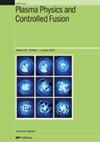Transport characteristic evaluation of runaway electrons in an ITER disruption simulation
IF 2.3
2区 物理与天体物理
Q2 PHYSICS, FLUIDS & PLASMAS
引用次数: 0
Abstract
In previous studies, it has been observed that the transport of energetic electrons decreases with increasing energy. This observation is a global and long-time-scale result, attributed to the space-averaged perturbations. In this work, we focus on the local and instantaneous transport characteristics of runaway electrons (REs) during the phase of tokamak disruption, with REs speeds close to the speed of light. To simulate the dynamics of REs, we utilize a particle tracing code called PTC. By coupling PTC with the MHD code JOREK, we are able to study the energy and spatial dependence of RE transport. Our investigations reveal that the finite orbit width (FOW) effect plays an important role in RE transport. This effect is influenced by the relative direction of the electron drift and the magnetic field line. Specifically, the FOW effect strengthens the transport when the drift direction aligns with the deflecting direction of the field line. And we compare the transport profiles among three time slices: at the beginning of the thermal quench, during the thermal quench, and at the beginning of the current quench. In this ITER disruption simulation, the perturbation scale is strong and is up to 0.05 at developed thermal quench stage. It is reasonable that the influence of FOW effect on transport is less than that of magnetic perturbation even if the energy of REs is about hundreds MeV and the orbit width is equal to or greater than the perturbation length. These analyses provide insights into the mechanisms of RE transport based on magnetic perturbations.热核实验堆破坏模拟中失控电子的传输特性评估
在以前的研究中,已经观察到高能电子的传输随着能量的增加而减少。这一观测结果是一个全局性的长时段结果,归因于空间平均扰动。在这项工作中,我们重点研究失控电子(REs)在托卡马克破坏阶段的局部和瞬时传输特性,REs的速度接近光速。为了模拟REs的动力学,我们使用了一种名为PTC的粒子追踪代码。通过将 PTC 与 MHD 代码 JOREK 相结合,我们能够研究 RE 传输的能量和空间依赖性。我们的研究发现,有限轨道宽度(FOW)效应在 RE 传输中起着重要作用。这种效应受电子漂移和磁场线相对方向的影响。具体来说,当漂移方向与磁场线的偏转方向一致时,有限轨道宽度效应会增强传输。我们还比较了三个时间片的传输剖面:热淬火开始时、热淬火期间和电流淬火开始时。在这次 ITER 破坏模拟中,扰动尺度很强,在发达热淬火阶段高达 0.05。即使 REs 的能量约为数百 MeV,轨道宽度等于或大于扰动长度,FOW 效应对传输的影响也小于磁扰动的影响,这是合理的。这些分析为基于磁扰动的RE输运机制提供了启示。
本文章由计算机程序翻译,如有差异,请以英文原文为准。
求助全文
约1分钟内获得全文
求助全文
来源期刊

Plasma Physics and Controlled Fusion
物理-物理:核物理
CiteScore
4.50
自引率
13.60%
发文量
224
审稿时长
4.5 months
期刊介绍:
Plasma Physics and Controlled Fusion covers all aspects of the physics of hot, highly ionised plasmas. This includes results of current experimental and theoretical research on all aspects of the physics of high-temperature plasmas and of controlled nuclear fusion, including the basic phenomena in highly-ionised gases in the laboratory, in the ionosphere and in space, in magnetic-confinement and inertial-confinement fusion as well as related diagnostic methods.
Papers with a technological emphasis, for example in such topics as plasma control, fusion technology and diagnostics, are welcomed when the plasma physics is an integral part of the paper or when the technology is unique to plasma applications or new to the field of plasma physics. Papers on dusty plasma physics are welcome when there is a clear relevance to fusion.
 求助内容:
求助内容: 应助结果提醒方式:
应助结果提醒方式:


